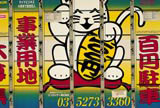Street inspiration
Street Graphics Tokyo might not be beautiful, but it’s a good starting block if you’re looking to be inspired by Japan, explains Nick Finney

I can see it all now – client calls the studio, wants to come in and talk about a new venture: a sushi bar, a Japanese restaurant, a yakuza café or something equally mouth-watering. ‘Quick, I need some stuff on Tokyo,’ is the cry that goes up. Almost immediately someone is sent scampering, clutching wads of petty cash. A search for some prior knowledge, a hunt for inspiration, a trawl through the funkier bookshops in W1. And what do they come back with?
As a reference book this almost works. I’m looking to flick through quickly and get a feel for what street graphics in Tokyo are all about. OK, so the title is confusing. So too then are the other books in the series: Street Graphics Cubaà and Street Graphics India. I mean what are street graphics? Initially, I thought signs – you know, signage. But no. In this instance, street graphics means whatever could be snapped on holiday or gathered from other willing contributors/holidaymakers and can cover anything from the ubiquitous Bladerunner-style cityscape to the humble, and really quite beautiful, phone card.
The running theme of the book is ‘street’. The phone cards are bought from flea markets presumably on, or just off, the street. Robot pets and self-assembly erotic manga dolls are equally purchased nearby; the latter from a vending machine. Wait, now there’s an idea.
The book is divided into eight sections, each covering such broad and fascinating subjects as ‘Tradition’, ‘Fashion’Ã or even (and here’s my sign bit) ‘Signs, Symbols and Services’. As there are roughly 14 pages for each, this book only begins to scratch the surface, so for further or more specific inspiration you would certainly need to broaden your search.
What little text there is serves as a light introduction to the book and a thumbnail sketch of Tokyo’s culture. However, the captions are slightly more informative: ‘Wanted posters featuring suspected Aum Shinrikyo
cult members’. To find out what Aum Shinrikyo is you’ll need to look elsewhere too. Quotes are dotted throughout the book, this one caught my fancy: ‘Tokyo – finally a country where people really understand the importance of being urban’. Now, I thought Tokyo was a city?
With our new client now breathing down our necks the fastest way we can gain this sort of information/inspiration is by clicking the search icon on our Internet browser. You can get more information faster, and go deeper into your target area. You can also spin off on a tangent and end up accidentally ordering a set of ornamental throwing stars. The result is usually a raggedy set of laserprints and some useless downloaded images too low-res to contemplate. This book is a start towards a neater collection of inspiration, the great shame is that it is not a beautiful collection.
In my imaginary scenario, the client would pay for us to travel to Tokyo to immerse ourselves in its culture and return with a headful of great design solutions. And, I’d be able to put together an altogether greater tome and do some justice to the place. That is only an imaginary happy ending though.
Nick Finney is a director at NB Studio
Street Graphics Tokyo by Barry Dawson is published on 21 October by Thames & Hudson, priced £12.95
-
Post a comment



